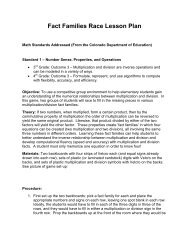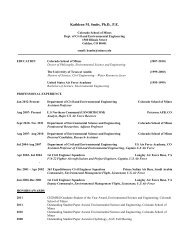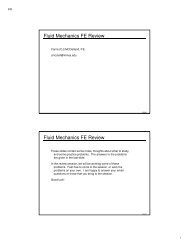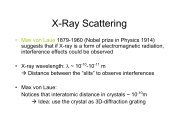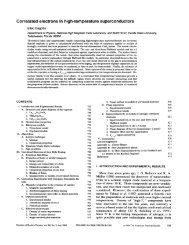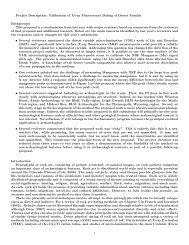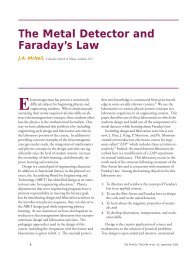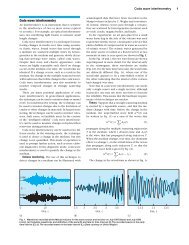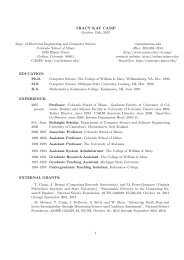Debris Basin and Deflection Berm Design for Fire-Related Debris ...
Debris Basin and Deflection Berm Design for Fire-Related Debris ...
Debris Basin and Deflection Berm Design for Fire-Related Debris ...
You also want an ePaper? Increase the reach of your titles
YUMPU automatically turns print PDFs into web optimized ePapers that Google loves.
<strong>Debris</strong>-Flow Mitigation <strong>Design</strong><br />
of the channel, <strong>and</strong> g 5 acceleration of gravity, all in<br />
consistent units.<br />
Two implicit assumptions must be met <strong>for</strong> Eq. 9 to<br />
be conservative with respect to continuity of flow (Q<br />
5 vA): (1) the cross-sectional area of flow behind the<br />
deflection berm is at least as large as that in the<br />
natural channel upstream of the berm <strong>and</strong> (2) the flow<br />
velocity behind the berm is similar to that in the<br />
channel upstream of the berm.<br />
Eq. 9 assumes that the effective height of the berm<br />
is not reduced due to debris-flow deposition behind it.<br />
If deposited material is not removed from behind the<br />
berm after each debris flow, the design height of the<br />
berm should be increased by the expected depth of<br />
deposition in order to maintain adequate freeboard.<br />
The decision whether to construct a higher berm or to<br />
specify timely removal of deposited material will<br />
depend on characteristics of the debris-flow processes<br />
(frequency <strong>and</strong> magnitude of events), site considerations<br />
(e.g., material availability <strong>and</strong> ease of access),<br />
<strong>and</strong> anthropogenic factors (e.g., the responsibility of<br />
the agency managing the berm).<br />
As discussed by Prochaska et al. (2008b), the height<br />
of the channel banks will effectively limit the<br />
maximum debris-flow depth <strong>and</strong> thus will provide a<br />
conservative estimate of h <strong>for</strong> use in Eq. 9. For curved<br />
berm alignments, the value of Dh can be obtained<br />
from Eq. 10 using a velocity predicted from Table 2<br />
or by other methods discussed by Prochaska et al.<br />
(2008b). Use of Eq. 10 in this setting will not<br />
encounter the difficulties with the estimation of R c<br />
that are discussed by Prochaska et al. (2008b),<br />
because the berm alignment will be an engineered<br />
curve rather than a natural channel bend. For straight<br />
berm alignments, Dh should be obtained from Eq. 4<br />
following the guidelines presented above. In the case<br />
of flowing debris striking an obliquely oriented runup<br />
slope, the velocity (v) used in Eq. 4 should be the<br />
slope-normal component of velocity (Mears, 1981),<br />
that is the flow velocity multiplied by sin d (as defined<br />
in Eq. 5).<br />
If flow past the deflection berm is supercritical <strong>and</strong><br />
cross-wave maxima occur at the outer bank, the<br />
superelevation in Eq. 9 (Dh) could be double that<br />
predicted by Eq. 10 (Pierson, 1985). Un<strong>for</strong>tunately, it is<br />
not currently possible to predict the locations where<br />
maximum cross-wave heights will occur (Iverson,<br />
2005). It is also not possible to design the berm to<br />
preclude supercritical flow, as cross waves that might<br />
develop higher in the natural channel are still able to<br />
continue far downstream (Chow, 1959). Thus, the<br />
deflection berm may become overtopped if maximum<br />
cross-wave heights occur on the outer bank of the bend.<br />
Given the uncertainty in the presence <strong>and</strong> location<br />
of cross-wave interferences, it may be uneconomical<br />
to design the berm height <strong>for</strong> these sporadic increases<br />
in superelevations. If space allows, a more economical<br />
option would be to construct a second berm<br />
downslope of <strong>and</strong> parallel to the main deflection<br />
berm (e.g., Nasmith <strong>and</strong> Mercer, 1979). For berms<br />
with similar top widths <strong>and</strong> side slopes, the construction<br />
of two smaller berms with heights h 1 <strong>and</strong> h 2 will<br />
always require less fill placement than a single berm<br />
with a height of h 1 + h 2 . This second berm would<br />
provide additional security against overtopping of the<br />
first berm from cross-wave amplification or from<br />
reduced freeboard caused by the failure to remove<br />
deposited material.<br />
<strong>Berm</strong> Cross Section<br />
The top of the berm should be at least 10 ft (3 m)<br />
wide if it is to be used <strong>for</strong> maintenance <strong>and</strong> cleanout<br />
access (Sherard et al., 1963). A narrower top width<br />
may be used if maintenance <strong>and</strong> cleanout access is<br />
provided from behind the berm rather than from on<br />
top of it, but narrower widths will make placement<br />
<strong>and</strong> compaction of the fill near the berm crest more<br />
difficult (Fell et al., 2005).<br />
The side slopes of a deflection berm should be<br />
sufficiently stable against all anticipated loading<br />
conditions, <strong>and</strong> steeper slopes will help to lessen the<br />
effects of runup (Eq. 4). Previous designs have used<br />
berm slopes as steep as 1.5:1 (horizontal:vertical)<br />
(Martin et al., 1984; VanDine, 1996). In Colorado a<br />
deflection berm may be classified as a Diversion Dam,<br />
<strong>and</strong> the berm slopes must con<strong>for</strong>m to a minimum<br />
acceptable factor of safety of 1.3 (State of Colorado,<br />
2007).<br />
Earthen berms are well suited to withst<strong>and</strong> impact<br />
<strong>for</strong>ces due to their large mass (Mears, 1981). To<br />
account <strong>for</strong> the impact of a debris flow, a lateral <strong>for</strong>ce<br />
equal to the estimated debris impact <strong>for</strong>ce (Eq. 5 <strong>and</strong><br />
6) can be applied to the upslope face of the berm<br />
during analysis of the downstream face stability.<br />
Stability of the berm against bearing capacity failure<br />
<strong>and</strong> sliding on its foundation due to the impact load<br />
should also be checked, with resulting factors of<br />
safety of at least 3 <strong>and</strong> 1.5, respectively (Das, 1999).<br />
The downstream face of the deflection berm should<br />
be vegetated or otherwise protected to prevent<br />
erosion. The upslope face of the berm should be<br />
armored to protect it against debris-flow scour. Given<br />
the likelihood of a supply of boulders already on the<br />
debris fan, riprap may be the most economical choice<br />
<strong>for</strong> slope armoring. Riprap used to protect embankment<br />
dam slopes against wave action is sized so that it<br />
is large enough to dissipate the wave energy without<br />
being displaced (Fell et al., 2005), but if this same<br />
Environmental & Engineering Geoscience, Vol. XIV, No. 4, November 2008, pp. 297–313 309



